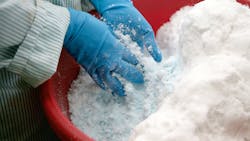Solids Handling: Six Factors That Improve Agglomerates
With liquids, you open the valve, and (hopefully) the material runs out. However, working with solids is a more interesting challenge. Poor flow is a given with most solids, and predicting the flow characteristics is a difficult and expensive proposition.
One of the ways to improve flowability in solids is by agglomerating the particles. However, many of these particles are weakly held together and break easily on subsequential handling. This is a property that is difficult to predict. It would be nice to have an inexpensive, well-established test method or procedure that would allow you to predict the strength beforehand. Sure, there are tests and procedures to guide you on the correct bin or chute design, but these are developed from experiments after the particles have been created. I’d like to have this property before I make the particles.
Also, test methods take time and are often qualitative/very subjective. Sometimes, you must repeat the tests because of changes in the particle size. If your plant has been working with solids, you are probably familiar with this scenario: the balance of cost versus usable results. To make the situation more complicated, fine particles like to clump or stick to equipment. This can be a blessing or a curse, as the larger particles may generally have better flowability. The secret is an understanding of the major factors that control agglomeration and clumping before you make the product.
Clumping is just unintended agglomeration, and we can use it to reduce the dustiness of a material or make it flow easier. The last thing you need in a pharmaceutical plant is for a bulk bag of acetaminophen to come in as a solid block (it has happened). The methods and mechanisms available to agglomerate particles are the same ones we use to prevent clumping. When you want to agglomerate particles, keep these six processes in mind.
- Partial dissolution – Most crystalline products have very reactive surfaces. Wetting the surface, followed by slight heating of the solids, cements the particles together. Keeping the particles moving is important to prevent the solids from sticking to other surfaces. One of the simplest methods to agglomerate particles is to suspend the solids and spray a little liquid on them.
- Chemical reaction – The most common reaction is the formation of hydrates. This improves density and forms bridges between particles. Oxidation or reduction of the particles is less common but can release gases or form condensable products that form a sticky film on the solids.
- Change of phase – About one-third of all organics have at least one polymorph, and many of the effective pharmaceuticals are not the most stable form of the chemical. Clumping happens when the solids aren’t moving. A similar process can occur with amorphous organics since the crystalline form is at a lower potential energy. Temperature control is very important with this method. I’ve had polymorphs separated by one degree, and the desired product is the unstable form.
- Attrition – Sometimes, a little attrition is a good thing. Breakage of the particles releases energy that is confined to the surface of the solids as an electrostatic charge and a higher charge-to-mass ratio. The increase makes the particle-size distribution wider (see particle size below). Milling and handling operations often participate in this process. This technique can be beneficial when tableting a product as the excess energy supplements the tableting pressure.
- Viscous films –The interstitial solvent that remains in the voids can be released during heating or cooling of the solids. As the solvent partially evaporates, it leaves behind a sticky surface on the particle that can allow bridging of the particles. We had a product that produced water as it reacted. We intentionally under-dried it before the agglomeration step to form stronger clumps.
- Particle size – The width of the particle size distribution (PSD) can improve agglomeration. Narrow PSD does not allow for smaller particles to occupy the voids around larger particles, so some particles are left out of the agglomerated particles. I’ve often observed that a PSD that follows the Fibonacci series is easier to agglomerate as the resulting particle resembles stronger particles that are seen in nature. Finer particles have higher specific surface area and more particle-particle contact, resulting in higher shear forces. In addition, the Van der Waals forces increase rapidly, with finer particles bringing that energy to the process.
The major factor in the previous list is the presence of excess solvent or solvent vapor. That is where most of the agglomerate problems reported in the chemical and pharmaceutical industry are found. Hopefully, you’ll find these six processes useful in looking at or improving your methods of agglomeration.
About the Author
Tom Blackwood, Solids Advice columnist
Contributing Editor
Tom Blackwood, a veteran engineer who has dealt extensively with solids over the course of his career, contributes regularly to Chemical Processing and serves as the Solid Advice columnist.

